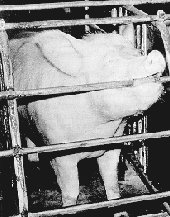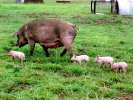Indicator 6.2
Issue: The welfare of breeding pigs - pregnant sows
Indicator: Sales of pigmeat from progeny of breeding sows kept in stall or tether systems
- Importance of the issue
- Evidence of welfare importance
- How supermarkets can help
- Indicator of breeding pig welfare
Importance of the Issue
 Sow stalls and tethers are systems of keeping
pregnant pigs in such close confinement they are unable to exercise or
even turn around throughout their 16-week pregnancy. Confined sows show
abnormal, repetitive behaviours, and suffer higher levels of foot
injuries, lameness, pain from infected cuts and abrasions, weakened
bones and muscles, urinary infections and heart problems.
Sow stalls and tethers are systems of keeping
pregnant pigs in such close confinement they are unable to exercise or
even turn around throughout their 16-week pregnancy. Confined sows show
abnormal, repetitive behaviours, and suffer higher levels of foot
injuries, lameness, pain from infected cuts and abrasions, weakened
bones and muscles, urinary infections and heart problems.
Sow tethers will be prohibited in the EU by 2006, whilst the use of
individual sow stalls for pregnant pigs for all but the first 4 weeks
after service will be banned from 1st January 2013. Several
EU countries have already banned sow stalls and tethers on a unilateral
basis ahead of EU-wide bans. These include Finland, Sweden, and the UK.
Supermarkets selling imported pigmeat produced using these methods can
undermine animal welfare progress on this issue.
Evidence of Welfare Importance
Confined sows carry out meaningless, repetitive motions, known as stereotypies. Experts regard these abnormal behaviours as outward signs of stress and suffering. They are the only behavioural means available for the highly frustrated sow to attempt to ‘cope’ with her confinement. Stereotypic behaviours include bar-biting, sham-chewing (chewing the air), shaking the head from side to side, repeated nosing in the empty feed trough, and attempting to root at the concrete floor.
In its 1997 Report on pig welfare, the European Commission’s expert Scientific Veterinary Committee (SVC) concluded:
“Since overall welfare appears to be better when sows are not confined throughout gestation [pregnancy], sows should preferably be kept in groups”.
The Report went on to say that sow stalls have “major disadvantages” for welfare; “The major disadvantages for sow welfare of housing them in stalls are indicated by high levels of stereotypies, of unresolved aggression and of inactivity associated with unresponsiveness, weaker bones and muscles and the clinical conditions mentioned above.” The Report stated, “In general, sows prefer not to be confined in a small space” and they “find the confinement aversive”.
As the SVC noted, sows kept in stall and tether systems often suffer a range of health problems, such as foot injuries, lameness, and long-term pain from infected cuts and abrasions. Lack of exercise leads to weakened bones and muscles. Being unable to move freely also causes greater levels of urinary infections. They may suffer heart problems, which can be evident by higher mortalities due to stress when being transported for slaughter.
Not surprisingly, the European Commission itself concluded that sow stalls “are causing serious welfare problems to the animals” (EU Commission, 2001).
How Supermarkets Can Help
 Supermarkets can help by selling only pigmeat
produced without the use of sow stalls or tethers during the breeding
phase. Supermarket procurement policies for pigmeat should be clear
that meat and processed products produced from the progeny of sows kept
in stalls and tethers is not acceptable. This policy should be fully
enforced at all times throughout company product ranges, and should
cover both own label and branded products.
Supermarkets can help by selling only pigmeat
produced without the use of sow stalls or tethers during the breeding
phase. Supermarket procurement policies for pigmeat should be clear
that meat and processed products produced from the progeny of sows kept
in stalls and tethers is not acceptable. This policy should be fully
enforced at all times throughout company product ranges, and should
cover both own label and branded products.
Indicator of Breeding Pig Welfare
The following question forms the ‘Race to the Top’’ indicator of supermarket performance on breeding pig welfare:
- What proportion of your company’s total pigmeat sales volume in each of the following product categories is produced from the progeny of breeding sows kept in stall or tether systems: Own label fresh pigmeat; branded fresh pigmeat; own label bacon and ham; branded bacon and ham; own label processed pigmeat; branded processed pigmeat; own label ready made meals containing pigmeat ingredient; branded ready made meals containing pigmeat ingredient?
Desired Outcome
Race to the Top encourages supermarkets to they sell 100% stall & tether-free pigmeat across their entire product range (own label and branded).

